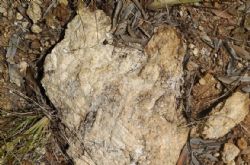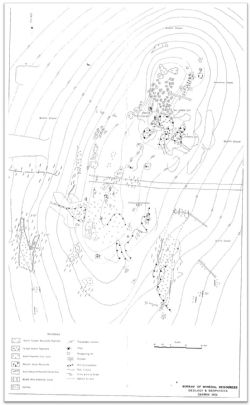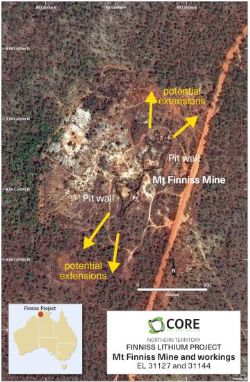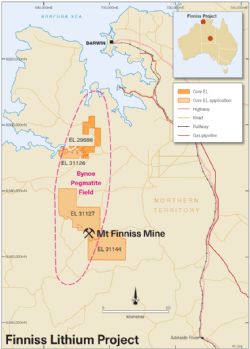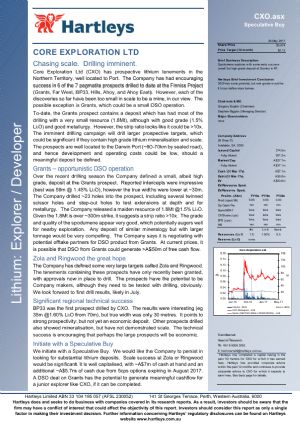 Rock Chip Assays Confirm Potential of Finniss Lithium Project
Rock Chip Assays Confirm Potential of Finniss Lithium Project
Adelaide, May 25, 2016 AEST (ABN Newswire) - Core Exploration Ltd ( ASX:CXO) is pleased to announce that initial sampling of the Mt Finniss Mine (the largest historically producing pegmatite mine in the Northern Territory) within the Finniss Lithium Project has identified spodumene and other lithium minerals with lithium grades up to 0.8% Li2O.
ASX:CXO) is pleased to announce that initial sampling of the Mt Finniss Mine (the largest historically producing pegmatite mine in the Northern Territory) within the Finniss Lithium Project has identified spodumene and other lithium minerals with lithium grades up to 0.8% Li2O.
Highlights:
- Spodumene and other lithium minerals have been identified by Core in and around the numerous historic pegmatite mine workings in the Finniss Lithium Project
- Results received from Core's first pass reconnaissance rock chip sampling from Mt Finniss Pegmatite Mine in the NT assay up to 0.8% lithium (Li2O)
- A further 25 historic tin tantalum pegmatite mines in the lithium prospective Bynoe Pegmatite Field are currently being evaluated, with first updates from some of these mines expected next month
- Upon receipt of all assay results Core will prioritise targets for a second round of sampling, with the objective of selecting initial targets for drilling within the Bynoe Pegmatite Field
The assay results received represent Core's first round of sampling on its Finniss Lithium Project, and confirms the enriched lithium contents of the pegmatites within Core's Finniss Lithium Project, and also highlights the potential value of Core's large and dominant tenement position over a number of lithium rich pegmatite fields in the NT.
Lithium assays up to 7,859ppm (0.8%) Li2O were recorded in Core's first assays of rock chip samples from Mt Finniss Mine indicating the pegmatite system has the potential to host economic grades of lithium. Lithium assays of the pegmatites sampled by Core in and around Mt Finniss Mine have highly enriched lithium contents that averaged well above 1000ppm (0.1%) Li2O (Table 1, see link below).
Core's mapping has also identified spodumene and a range of lithium minerals in outcrop and in and around mine workings and dumps on the Mt Finniss Project (Figure 1, see link below).
Core's portfolio in the Bynoe Pegmatite Field includes a further 25 historic tin tantalum pegmatite mines for which sampling is underway. The Company anticipates receipt of first assay results from these mines in June.
To date there has been no systematic lithium exploration and the potential of the area has yet to be properly assessed given all of the historical work was primarily focused on defining tin-tantalum mineralisation.
Core's first reconnaissance sampling sought to characterise the lithium chemistry of various zones in the pegmatites and adjacent host wall rocks. Core will now be able to utilise this important lithium focussed data to target systematic sampling of the zoned pegmatites.
In this tropical environment near Darwin, much of the near surface material is weathered by soil and water processes and visual identification of minerals susceptible to weathering (spodumene, feldspars and other minerals) can be challenging (Figures 1 & 2, see link below).
Analysis of NTGS data from the Bynoe Pegmatite Field and other published research on spodumene shows that surface weathering of spodumene to clay minerals results in a decreased lithium levels in surface samples. As a result, lithium grades may be expected to be increase at depth and with drilling.
Results
Lithium assays up to 7,589ppm (0.8%) Li2O were recorded in Core's fist rock chip results and many of the samples from Mt Finniss Mine assayed above 1000ppm lithium (Table 1).
Lithium assays of the pegmatites sampled in and around Mt Finniss averaged well above 1,000ppm (0.1%) Li2O indicating that the pegmatite Mt Finniss pegmatite system is highly enriched in lithium (Table 1) and has the potential to host economic grades of lithium.
Core's Finniss Lithium Project covers over 200km2 and 25 other historic pegmatite mines, so has also have the potential to host economic grades of lithium on a large scale.
Next Steps
Core's initial sampling is characterising the lithium chemistry of various geological zones within the pegmatites and will be used to potentially target the most lithium rich zones. This work represents the first systematic assessment of these historic mines and surrounding tenements for lithium, and further results from this initial programme are expected in coming weeks.
Core has also been examining historic mining reports which highlight the potential for extension of the Mt Finniss pegmatite north and south of the existing pits and extensive waste dumps (Figure 3, see link below).
Core is currently testing geochemical and satellite spectral mapping techniques to map extensions to mined pegmatites (like Mt Finniss) with the potential to also apply this technique to finding new pegmatites within the Finniss Project.
As the wet season continues to recede Core will have physical access to a larger proportion of the mine workings within the Finniss Lithium Project.
Core's field work is focussed on ranking pegmatites with potential for economic grade and scale to prioritise for drill testing. Further updates on this work will be made progressively over coming weeks.
Project Background
Core's Finniss Lithium Project covers over 200km2 and 25 historic pegmatite mines the Bynoe pegmatite field, which includes the Mount Finniss Tin Tantalum Mine - the largest historically producing tin and tantalum pegmatite mine in NT (Figures 3 & 4, see link below).
As with Greenbushes in WA, one of the world's largest spodumene deposits, the Bynoe Pegmatite Field also has a 100 year history of tin and tantalum production before the potential for economic lithium was recognised.
Core holds close to 3,000km2 of tenure over lithium rich pegmatite provinces in the NT including the Bynoe, Anningie and Barrow Creek pegmatite fields. The scale of Core's holdings and the volume pegmatite swarms within them potentially positions Core as a significant player as lithium supply markets evolve and mature.
The Bynoe region has substantial infrastructure advantages being close to grid power, gas and rail infrastructure and within easy trucking distance by sealed road to Darwin Port - Australia's nearest port to Asia (Figure 4).
To view tables and figures, please visit:
http://abnnewswire.net/lnk/XB1LU84U
About Core Lithium Ltd
 Core Lithium Ltd (ASX:CXO) is an Australian hard-rock lithium company that owns the Finniss Lithium Operation on the Cox Peninsula, south-west and 88km by sealed road from the Darwin Port, Northern Territory. Core's vision is to generate sustained shareholder value from critical minerals exploration and mining projects underpinned by strong environmental, safety and social standards.
Core Lithium Ltd (ASX:CXO) is an Australian hard-rock lithium company that owns the Finniss Lithium Operation on the Cox Peninsula, south-west and 88km by sealed road from the Darwin Port, Northern Territory. Core's vision is to generate sustained shareholder value from critical minerals exploration and mining projects underpinned by strong environmental, safety and social standards.

![abnnewswire.com]()
Related Companies
Social Media
Share this Article

 ASX:CXO) is pleased to announce that initial sampling of the Mt Finniss Mine (the largest historically producing pegmatite mine in the Northern Territory) within the Finniss Lithium Project has identified spodumene and other lithium minerals with lithium grades up to 0.8% Li2O.
ASX:CXO) is pleased to announce that initial sampling of the Mt Finniss Mine (the largest historically producing pegmatite mine in the Northern Territory) within the Finniss Lithium Project has identified spodumene and other lithium minerals with lithium grades up to 0.8% Li2O.  Core Lithium Ltd (ASX:CXO) is an Australian hard-rock lithium company that owns the Finniss Lithium Operation on the Cox Peninsula, south-west and 88km by sealed road from the Darwin Port, Northern Territory. Core's vision is to generate sustained shareholder value from critical minerals exploration and mining projects underpinned by strong environmental, safety and social standards.
Core Lithium Ltd (ASX:CXO) is an Australian hard-rock lithium company that owns the Finniss Lithium Operation on the Cox Peninsula, south-west and 88km by sealed road from the Darwin Port, Northern Territory. Core's vision is to generate sustained shareholder value from critical minerals exploration and mining projects underpinned by strong environmental, safety and social standards.


